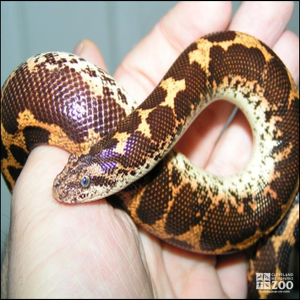 The Kenyan Sand Boa is one of the smallest boas with the females being less than 3 feet in length. They have a more or less a pointed tail and is heavy bodied, resembling a sausage. They can weigh up to four pounds. The body coloring is yellow or orange with brown splotches. It has nostrils and small eyes on the top of its head. They can hide in the sand with its eyes and nostrils above the sand to wait for their prey. Although if there is no prey, it can live for a year without food. They can live up to 20 years.
The Kenyan Sand Boa is one of the smallest boas with the females being less than 3 feet in length. They have a more or less a pointed tail and is heavy bodied, resembling a sausage. They can weigh up to four pounds. The body coloring is yellow or orange with brown splotches. It has nostrils and small eyes on the top of its head. They can hide in the sand with its eyes and nostrils above the sand to wait for their prey. Although if there is no prey, it can live for a year without food. They can live up to 20 years.
Location: Education Animals
Share:
Range
Africa, Kenya, and range includes Sudan, Ethiopia and Somalia
Habitat
Desert, scrub savannahs
Conservation Status
Primary Threats
Human-Wildlife Conflict. Pet Trade.
Gestation
Four months
Litter
4 to 20 live young
Behavior
The Kenyan sand boa is a constrictor, burrows under the sand, cannot coil, hides under rocks and burrows to stay out of heat and wait for prey. It drags its prey under the sand to suffocate it. During hot weather it seeks refuge beneath stones and burrows in other unused mammal passages.
Reproduction
Become sexually mature at 2-3 years. The male may have to drag the female out of the sand to mate. They breed from November to April. Being oviparous the eggs are retained in the mother's body until they are born. 10 - 20 babies are born in the late summer. The young are 8 - 10 inches long.
Wild Diet
Small mammals and lizards
Zoo Diet

